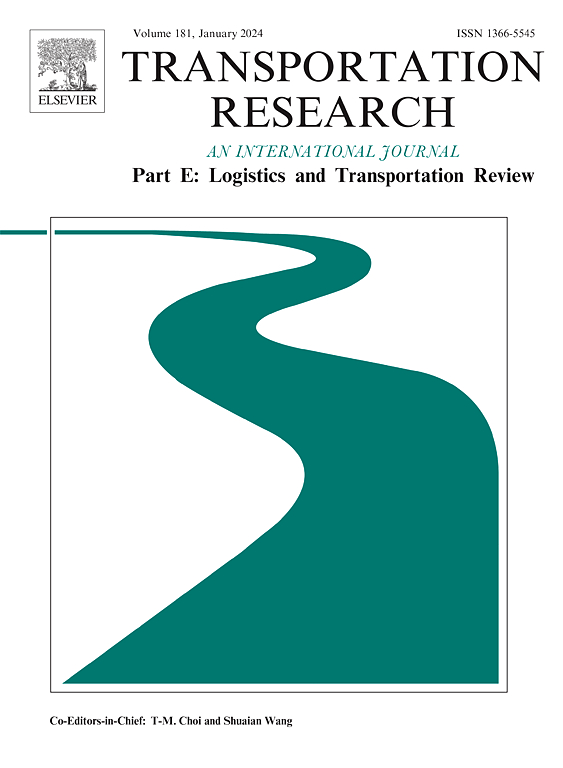考虑楼面荷载和独立通道的多目标双层走廊分配问题
IF 8.8
1区 工程技术
Q1 ECONOMICS
Transportation Research Part E-Logistics and Transportation Review
Pub Date : 2025-10-04
DOI:10.1016/j.tre.2025.104453
引用次数: 0
摘要
目前对多层立体厂房布局的研究忽略了楼层荷载约束的影响以及对工人和物流的干扰,导致生产效率低下,运输风险增加。本研究考察了考虑楼层荷载和分离的工人-物流运输通道(DFCAP_FLSP)的双层走廊分配问题。为此,构建了一个包含设施配置约束、多类型运输距离计算约束和楼层装载约束的混合整数规划模型,以最小化物料搬运成本、员工步行距离和楼层装载间隙。随后,提出了一种多目标自学习模因算法(MOSLMA)来有效地求解DFCAP_FLSP问题。该算法采用线性规划实现两阶段解码,并利用Q-learning提高局部搜索性能。通过与遗传算法、多目标粒子群优化和非支配排序遗传算法II的4个基准实例对比实验发现,MOSLMA获得接近Pareto解的非劣解百分比最高(68.75%、93.18%、100%和87.5%),突出了MOSLMA的优势。最后,将所提出的布局和算法应用于减速器制造车间,方案对比表明所提出的布局结构在安全性和成本效益方面具有优越性。本文章由计算机程序翻译,如有差异,请以英文原文为准。
Multi-objective double-floor corridor allocation problem with floor loads and separated passages
Current research on multi-floor stereoscopic workshop layouts disregards the effects of floor load constraints and interference with the workers and logistics, which lead to low productivity and escalating transportation risks. This study examines a double-floor corridor allocation problem considering floor loads and separated worker-logistics transportation passages (DFCAP_FLSP). To this end, a mixed-integer programming model involving constraints on facility allocation, multi-type transportation distance computation, and floor loading is constructed to minimize material handling costs, employee walking distances, and floor loading gaps. Subsequently, a multi-objective self-learning memetic algorithm (MOSLMA) is developed to solve the DFCAP_FLSP efficiently. The algorithm employs linear programming to achieve two-stage decoding and utilizes Q-learning to improve local search performance. Comparison experiments conducted with the genetic algorithm, multi-objective particle swarm optimization, and non-dominated sorting genetic algorithm II for the four benchmark instances reveal that MOSLMA achieved the highest percentages of non-inferior solutions close to the Pareto solution (68.75%, 93.18%, 100%, and 87.5%), highlighting its advantages. Finally, the proposed layout and algorithm are applied to the reducer manufacturing workshop, and the scheme comparison indicates the superiority of the proposed layout structure in safety and cost-effectiveness.
求助全文
通过发布文献求助,成功后即可免费获取论文全文。
去求助
来源期刊
CiteScore
16.20
自引率
16.00%
发文量
285
审稿时长
62 days
期刊介绍:
Transportation Research Part E: Logistics and Transportation Review is a reputable journal that publishes high-quality articles covering a wide range of topics in the field of logistics and transportation research. The journal welcomes submissions on various subjects, including transport economics, transport infrastructure and investment appraisal, evaluation of public policies related to transportation, empirical and analytical studies of logistics management practices and performance, logistics and operations models, and logistics and supply chain management.
Part E aims to provide informative and well-researched articles that contribute to the understanding and advancement of the field. The content of the journal is complementary to other prestigious journals in transportation research, such as Transportation Research Part A: Policy and Practice, Part B: Methodological, Part C: Emerging Technologies, Part D: Transport and Environment, and Part F: Traffic Psychology and Behaviour. Together, these journals form a comprehensive and cohesive reference for current research in transportation science.

 求助内容:
求助内容: 应助结果提醒方式:
应助结果提醒方式:


